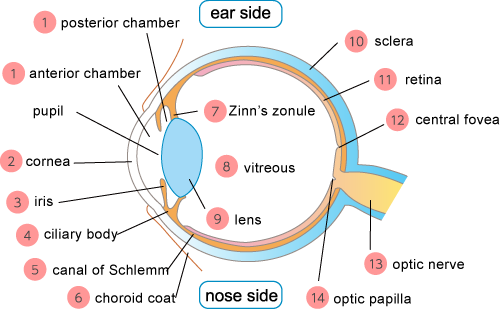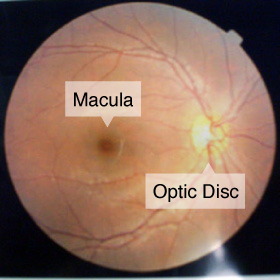Please note that every treatment, medication, and examination is decided by the doctors.

Funduscopy, anti-VEGF antibody treatment, and laser treatment is possible at Shinjuku-Higashiguchi Clinic.
Take an appointment for Retinal and Vitreous diseases at Shinjuku-Higashiguchi Clinic.
Symptoms

The symptoms of macular edema are blurry or wavy vision near or in the center of your field of vision, and colors might also appear washed out or faded. Macular edema is the build-up of fluid in the macula, an area in the center of the retina. The retina is the light-sensitive tissue at the back of the eye and the macula is the part of the retina responsible for sharp, straight-ahead vision.
Macular edema occurs when there is abnormal leakage and accumulation of fluid in the macula from damaged blood vessels in the nearby retina. It is also caused with other diseases such as diabetic retinopathy, retinal vein occlusion, and uveitis followed by behest’s disease and sarcoidosis.
Examination
Examination such as visual acuity test, dilated eye exam, and optical coherence tomography is needed to diagnose macular edema. A visual acuity test is essential to see how much epimacular membrane has affected the vision. A dilated eye exam is used to more thoroughly examine the membrane on the retina. Optical coherence tomography is a test that uses a special light and a camera to see a tomographic image of the retina. It detects the thickness of the retina and it’s useful in determining the amount of swelling in the macular edema
Treatment of Macular Edema
Macular edema can heal by having a treatment for the diseases mentioned above. If it doesn’t, the retina will keep getting damaged, which will make it difficult to recover. These are some treatments for macular edema.
Steroid Injection
Steroid (adrenocortical hormones) reduces the leakage from the blood vessels and heal the edema on the macular. But at the same time, steroid can increase the risk of diabetes so whole-body administration (both medication and injection) is avoided. Instead, steroid injection will affect intensively to the macular, by inserting the steroid directly to the eye.
It is done in the operating room to prevent infections. We use eyes numbing drops, and a long needle to insert the drugs. The patient doesn’t have to stay at the clinic after the surgery, but will may be asked to come back the next day to check the eye’s condition, and whether there aren’t any side-effects.
Steroid have a risk of increasing the eye pressure, and 5% of the patients need a treatment to lower the pressure, but less than 0.5% of them need a surgery for it. Other than that, risk of developing cataract, and bacterial infections were reported. The effect will last for few months, and steroid injection needs to be done again if macular edema reoccurs.
Vitrectomy
In this surgery, the vitreous and the internal limiting membrane will be detached to release the power that pulls the retina. Also, it will alleviate the edema by removing chemical substances and increase the oxygen partial pressure.
Please note that we do not perform this surgery at our clinic.
Laser Treatment
We observe the fundus to check the leakage of blood vessels and fluid on the macular, by having fluorescent fundus examination, and other examination using the slip lamp microscope. Laser treatment can stabilize vision by sealing off the leakage.
Anti-VEGF Injection
It is found that diabetic macular edema occurs when the amount of VEGF, a substance called vascular endothelial growth factor, increases in the eye. Anti-VEGF injection will prevent that by inserting anti-VEGF drug.
It is done in the operating room to prevent infections. We use eyes numbing drops, and a long needle to insert the drugs. The patient doesn’t have to stay at the clinic after the surgery, but will may be asked to come back the next day to check the eye’s condition, and whether there aren’t any side-effects.






